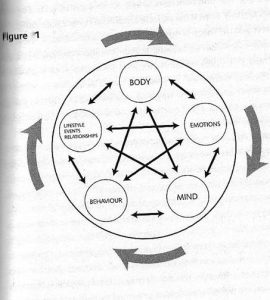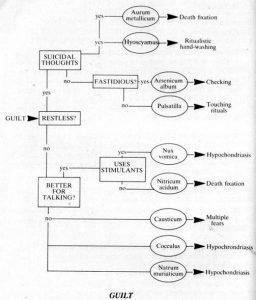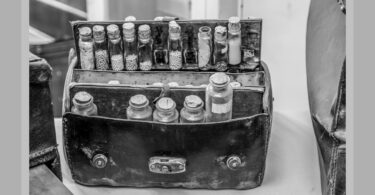So full of artless jealousy is guilt,
It spills itself in fearing to be spilt.
William Shakespeare, Hamlet
It is the genius of William Shakespeare that we still see his plays performed four centuries after he died. His canon of plays covers virtually every human emotion. Incredibly, he gave textbook psychiatric descriptions of conditions centuries before psychiatry as a medical discipline was even conceived.
In Hamlet we see one of the greatest depictions of depression. Hamlet, Prince of Denmark suffers from melancholy, or as we now know it, depression. Yet the other theme of the play is guilt, an emotion experienced by Hamlet’s uncle, King Claudius, because he had killed his own brother and usurped the throne.
It is Gertrude, Hamlet’s mother who says the above lines in an aside to the audience. By ‘it’ she means that lacking sophistication, the guilty give themselves away by trying to hide their guilt. That is, their thoughts, moods, actions and behaviour will reveal their underlying guilt as they try to hide it.
And of course, in Macbeth, his other great play with guilt as a major theme, he gives us Lady Macbeth, whose guilty conscience drives her insane. It is interesting that Shakespeare wrote the play in 1605, the year of the Gunpowder Plot, when conspirators made an abortive attempt to blow up King James I and his parliament. He wrote it to show the fearful consequences of murdering a king. The murderers develop guilty consciences, which drive them to their doom.
Guilt the negative emotion
Everyone experiences guilt at times in their lives although it is not usually as catastrophic as in Shakespeare’s tragedies. Nonetheless, there are degrees to which it can be experienced. It is when it becomes a dominant emotion that is can affect one’s wellbeing and one’s emotional, psychological and physical health.
Putting it very simply, guilt is a feeling or thought that one has committed a wrong, or failed in a duty or obligation. Note that I said a thought or feeling. I say this because it can be either something that is known and thought about, or it can be an emotion that cannot be directly explained or rationalised.
Different disciplines attempt to explain it in their own way. For example, in psychoanalytic theory, Freud said it was the result of tension between the superego and the ego. Cognitive psychologists, on the other hand, would rather aver that it is thought that creates the emotion. If you are convinced that you have caused harm, or betrayed someone, or failed in a duty or moral obligation, then the negative feelings of guilt will follow.
Causes of guilt
As we know in homoeopathy there are many ways that people fall ill or experience unease or dis-ease. Our actions, our thoughts, our emotions can all have a bearing, as well as extraneous events or influences upon us, be they injuries, injustices, infections, poisons and so on. Add to that the effects of inherited predispositions or miasms and it can get very complex.
The limitations of length in an article such as this preclude an in-depth study of guilt. Besides, it is the aim to give a little practical help when guilt starts to show up when you take a case.
There are basically six main causes of guilt:
- Guilt about not living up to one’s own moral code – this can be a philosophical code that one has developed or a religion that one follows. This can be a very powerful influence, of course, and ay transgression of that code can torture the person.
- Guilt after actual direct harm caused to someone – this is when an action or a dereliction of some sort caused actual harm to another, or breached the person’s own sense of what s right and what is wrong. The guilt experienced may be justified at some level, but its importance and magnitude can escalate dramatically until it manifests itself in the person’s thoughts, behaviour and health.
- Guilt about something the person wants to do – this could be the guilty secret that people often have. It could be affection for someone that is beyond reach, such as a sibling’s partner, or a desire to have adultery, to steal or to commit a perceived ‘sin.’ It could also be a vice that one cannot give up, a habit that one cannot break, or doubts about one’s sexuality, gender or proclivity.
- Guilt about imagined harm – this can arise from an irrational belief that some action (or even some thought) ‘might’ have harmed others. For example, a belief that by refusing to lend someone money they stole from someone and ended up in trouble. Or it could be you stole a girlfriend from someone and caused the ‘injured’ party to sink into depression.
- Guilt about having let someone down – this is common in grief, when one often wishes one had behaved differently or done more for someone. People often wish that they had done something positive before the person died, or that they should have told them how they felt. It is common to think that an omission could have prevented them from dying. ‘If only I had done… something!
- Guilt about being more fortunate than others. This can occur in families or in circles of friends or in survivors of disasters. The roots of this type of guilt may go very deep and may in fact be miasmic, or represent ‘inherited guilt or ‘inherited sin.’
The life cycle
This heading may make you think of school biology lessons when you looked at the different life cycles of insects, fish, frogs and other creatures on the evolutionary ladder. I am not, however, using the term here in the same sense. I am using it as a model for a person’s life. This has nothing to do with their development with age, but is to do with the different levels or spheres that make up one’s life at any point in time. And you will see that there is a cycle involved, certainly in the manner in which a condition, virtually any chronic medical condition, can affect them.
I use this model in my practice when I am working with patients and want to give them strategies to deal with their condition. You can focus on the dominant thing in their life, or on the main reason that they have consulted you. Indeed, I run through it, it gives further room to explore their thoughts, emotions and actions.
Yet to use the biology analogy a little longer, you will learn a certain amount about fish by dissecting them to look at their internal organs. But you won’t know how they move and feed without studying them in water. And you won’t learn about their behaviour with other fish and predators unless you observe them in a realistic environment. Even then you will not get to know about them fully unless you just become a total observer of them.
So it is in homoeopathic medicine. In order to help someone you need to know as much as possible about their condition, their symptoms and the things that make their symptoms better or worse. And ideally you want to know about their habits, their diet, their desires, their fears, their relationships and so on. These are all areas that one will explore in taking a homoeopathic history.
There are six levels or spheres of life that we need to consider:
- Body – what physical symptoms are complained of? For example, pain, stiffness, tiredness or fatigue.
- Emotions – how does it make the person feel? For example, anxious, sad, depressed, angry or jealous of others who are not affected. But going deeper, what emotions are impinging adversely upon the person’s enjoyment of life. In terms of this article, is guilt something that the person is aware of?
- Mind – how it affects the type of thoughts the person has? For example, pessimistic thoughts, negative thoughts, self-defeating thoughts, guilty thoughts.
- Behaviour – how it makes the person behave? For example, isolating them by avoiding things or people. Or by developing habits, e.g. smoking, drinking, taking drugs, having affairs, becoming inactive.
- Lifestyle – how it affects the person’s ability to do things, their relationships, and also how events in their life impact on them.
Now take a look at Figure 1. You will see the five spheres starting with the Body sphere at the top. If you follow it clockwise you will see that it follows the order that I mentioned above – body, emotions, mind, behaviour, and lifestyle. And note the outer circle that encloses the whole structure. This represents the individual’s whole self, their life. In other words the five spheres all make up part of the individual’s experience of life.
Notice also that there are double-headed arrows between the spheres. The outer arrows represent the general progression, because the order represents the way that a condition will tend to impact on a person.
If we think of a simple condition like an arthritic hip, you can see what I mean. The condition produces physical or body symptoms in the form of pain and limitation of movement. If these symptoms persist for a while, which they do, of course, they tend to affect the individual emotionally. They will start to feel something about the symptoms or about the condition. The emotions then make you think in a particular way. The condition may come to dominate one’s thoughts, with worry about how it will progress, how it is going to impact on one’s wellbeing, work and family. This can affect one’s behaviour in that one may stop doing certain things or take up various habits, including taking prescription drugs. . Immobility leads to less fitness, less health conscious decisions.
Finally, this may affect lifestyle and relationships. Again, this may intensify the condition at the physical level.
Notice also the inner double-headed arrows, for they represent the ways that the different spheres are affected by the other spheres. Indeed, each sphere is potentially affected by all of the others.
Thus, a physical condition has the potential to affect all of the spheres or levels of one’s life. This is very important, because the double-headed arrows also indicate that one has multiple potential ways in which one can affect a physical condition.
Chronic pain is, of course, more complex than acute pain to treat. This is because the pain matrix, which has two components, which operate in parallel with each other, mediates the way in which we perceive pain.
The lateral pain system seems to be responsible for processing the physical sensations, such as intensity of pain and its localization. It has much to do with acute pain; such as the pain you feel when part of the body is traumatised.
The medial pain system processes the emotional side of pain. It passes its information up medially, that means on the inside. And it does it through the limbic system. The information is then passed up to the prefrontal cortex.
So far I have talked about using the life cycle model with pain, but you can really use it for anything to help the person understand how it is impacting on their life. Further, you can use it to explore their emotions, their thinking to assess how much or how little any emotion is playing. Is it a result or a cause? Is it superficial or is it deep guilt? You will perhaps be surprised at how often guilt is bubbling away there, causing the emotional pot to seethe. Or to use another analogy, think of the guilt as an energy consuming monster that eats away at the person, eroding their confidence, their self esteem and intensifying their symptoms, so that it is indirectly the ruler of their life and the condition they are suffering from.
Guilt in homoeopathy
Sometimes an emotion like guilt will be very apparent and can be talked about and explored directly. One other occasions it is consciously hidden and may come out as trust is established in the consultation or series of consultations. In other cases it is deeply buried in the unconscious and has to be exposed by following clues and gently probing with your questioning.
Perfectionists often have guilt operating at a deep level, because they fear failure. On exploring this you may find that they fear failing because o their childhood experiences. Perhaps they had a domineering parent who only gave love if high expectations were met. Or perhaps a loving grandmother who boosted the person’s esteem died before they told them how much they had loved them. The guilt over the omission may have forced them to become perfectionists, so that they could live up to the image the grandmother had. There is nothing wrong in being a perfectionist, of course, but it is when they need help that an emotion like guilt may need dealing with.
Guilt remedies
There are many remedies that are very useful when guilt is exposed. The following are merely a few that I have found helpful and I offer them for the reader to add to in their own practice.
Figure 2 is a flowchart from my book Homeopathy: Heart & Soul and also from The Art of Homeopathy – remedy selection made easy.
Arsenicum album – for guilt in fussy, fastidious, restless types. If they perceive that they have caused an injury, slight or wrong they are liable to suffer anguish out of proportion to the cause. They will be unable to settle and may sink into deep anxiety state.
Aurum metallicum – for guilt in people prone to depression, who are liable to take guilt feelings upon themselves. They often also have deep rooted guilt. They tend to be self-deprecating and may have self-destructive or suicidal thoughts. They do, however, fear death. They are particularly sensitive to noise and excitement.
Belladonna – It is a mistake to only think of this as an acute remedy, for it can work wonders in chronic guilt. Yet it is often during acute illnesses that flashbacks of deep guilt will resurface.
Causticum – for guilt after shock and bereavement. There may be an intense feeling of sympathy for others, but thinking about themselves only intensifies their own guilt. They need to be constantly distracted, because they fear failing anyone.
Cocculus – for guilt in capricious, dreamy types. They can become profoundly sad. They agonise over the health of others and may feel guilty that they are in some way responsible for a problem either directly, or thorough neglect or omission. They may be prone to hypochondriasis. They tend to be worse for movement and often complain of emptiness.
Coffea – for guilt in impressionable types. They are quick-thinkers and this is part of their problem. They will agonise about guilt feelings and probably suffer sleep problems as a result.
Graphites – for guilt in timid types prone to depression. They may be fidgety and tend to be overweight. They start or jump at the slightest thing and can be weepy on hearing emotional music. They may experience cobweb sensations over the face.
Hyoscyamus – for guilt in suspicious, talkative, immodest types. They tend to laugh at inconsequential things. They have a fear of dogs and of being poisoned. They can be prone to ritualistic hand-washing.
Ignatia – for guilt in introspective, changeable types. They can easily get things out of proportion and may be subject to the three S’s – sobbing, sitting and sighing. It is very common after bereavement.
Natrum muriaticum – for guilt in melancholic types who are worse for consolation. They may have a tendency to ‘nurture’ their guilty feelings. They crave salty food. They can be subject to lengthy bereavement reactions.
Nitricum acidum – for guilt in headstrong, irritable and prickly people. They may have a tendency to vindictiveness.
Nux vomica – for guilt in fiery, fastidious types who may be workaholics and high achievers. They may resort to stimulants, which can add to their guilt. They may be prone to hypochondriasis.
Pulsatilla – for guilt in timid, weepy, changeable types, who are better for being outdoors. They may bottle their guilt up. They may develop ritualistic behaviour. They tend to be thirstless. It is, of course, often thought of as a female remedy, but do not close your mind to it if the case fits.
Staphysagria – these people often suppress emotions, like anger and guilt. They can be hypersensitive to touch and are prone to hypochondriasis, temper tantrums and may need anger management help. They are easily offended.
Sulphur – it is common for these types to feel guilty, because they often have a strong sense of injustice. This may spring from deep-rooted guilt, or it can be superficial, resulting from perceived infringements on their own sense of morality.
They may be neat, but often have neglect polishing shoes, combing hair or some other aspect of appearance.
Veratrum album – for guilt in melancholic, indifferent types who are suffering from shock. They often have cold perspiration collecting on their brow. They can be destructive, critical and even quite rude. Deep held religious convictions are often present.







I am very impressed with the clarity of information. Thank you
Thank you so much for this detailed article . It’s very helpful and clear .